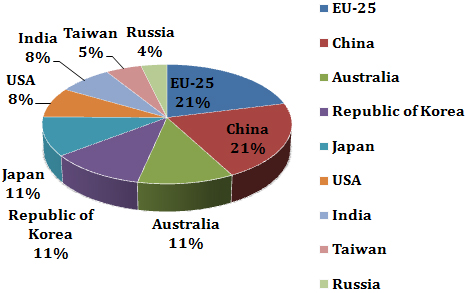ASEAN Moves to Expand Tourism
Jul. 18 – Tourism appears to be the next key developmental sector for the Association of Southeast Asian Nations (ASEAN), as it strives to further enhance and integrate the bloc’s regional economies and trade and investment flows.
As such, the ASEAN National Tourism Organizations (NTO) recently released a report titled the ASEAN Tourism Marketing Strategy (ATMS), which covers the ASEAN tourism industry and its marketing strategies for the next several years.
The report further outlines the region’s tourism development strategy which aims to foster an integrated tourism industry to include tours of multiple ASEAN countries over a single trip to allow for a more comprehensive tourist experience.
The five key strategic objectives of the ATMS are to:
- Ensure that there are an increased number of international visitors traveling to ASEAN who visit more than one country;
- Determine how the ASEAN NTOs can contribute to the overall positioning of the region as a preferred travel destination;
- Ensure that tourism is used as a development tool and incorporated into a marketing approach that is directed at meeting specific social, economic and cultural goals;
- Guide budgetary decisions related to positioning the region and various dimensions of the travel experience; and
- Work effectively together to promote travel within the region under the theme “ASEAN for ASEAN” which encourages greater intra-ASEAN people mobility.
According to Aung Zaw Win, Chairman of the ASEAN Tourism Product Development Working Group, tourists are now “more sophisticated and interested in unique experiences with immersion in local ways of life. [As such, ASEAN’s] new focus is on experiential and creative tourism that respects environment and culture.”
“An authentic travel experience involves meaningful engagement with the heritage, arts and special character of our ASEAN destinations,” Mr Win further added.
As a result, ASEAN recently started promotion of six new experiential and creative travel themes to encourage multi-country trips across the region, ranging from cuisine appreciation to tropical sports and recreation. Specifically:
- “The Tastes of Southeast Asia”;
- “ASEAN, a Tropical Paradise”;
- “World Class Cities”;
- “Experience Diverse Traditions”;
- “Sport and Relaxation”; and
- “Diverse Contemporary Creativity”.
Who actually visits?
Currently, over 40 percent of tourists to ASEAN come from just 9 nations: the United States, European Union, China, Australia, South Korea, Japan, India, Taiwan and Russia.
Of the top nine nations, the EU and China are ahead of the pack, comprising 21 percent each of ASEAN’s total visitors annually.
The graph below shows the share of ASEAN tourism amongst the top nine nations:

On the other hand, domestic tourism within ASEAN (e.g., Vietnam to Malaysia tourism) accounts for nearly 47% of ASEAN’s total tourism.
Furthermore, the number of ASEAN-bound tourists has grown on an annual basis, and is forecasted to eclipse 100 million by 2015.

In the report, the ASEAN NTO outlined its main priorities in targeting specific tourism markets and outlined its proposals for 2012-2015.
2013: Experimental and creative markets
This sector specifically targets the attention of travelers looking to celebrate more unique festivals, holidays and indigenous cultures throughout the various ASEAN countries through a “locals’ eye” view. Creative market travelers are likely to be more interested in unique cultural arts and crafts, cuisines and experiences compared to the typical tourist.
The report concluded that they also tend to be well-educated, fairly well-traveled and looking more for experiences of personal development and self-fulfillment during a trip compared to the more typical sightseeing and shopping experiences.
2014: Incentives market and adventure travelers
Incentive market tourism refers to the “I” in MICE (Meetings, Incentives, Conventions, and Exhibitions) tourism, which seeks to target individuals travelling for businesses and companies engaging in overseas business activities. The incentive market also accommodates employees that receive reward offers from their employers due to high employee performance.
While meetings, conventions and exhibitions require the availability of special facilities and a unified infrastructure (which are not yet prevalent throughout ASEAN), the incentive market, however, can be accommodated through the use of existing high-end leisure facilities.
Also, thanks to ASEAN’s ever increasing integration of economic activities and various free trade agreements with many neighboring countries, this type of business travel is likely to continue to be an important dimension of the overall tourism sector.
Furthermore, ASEAN has made a concerted effort to attract adventure travelers to come to the region. Adventure tourism primarily caters to tourists that broadly seek out more “extreme” and adventurous types of tourist activities such as rafting, bungee jumping, hiking and trekking – things that adventurers can easily find throughout Southeast Asia’s various regions and landscapes.
2015 and onwards: Seniors and long stay
The report concludes that the plan for 2015 and onwards, assuming that all identified markets will have been serviced, is to develop the seniors market (i.e., tourists that are over the legal age of retirement in their respective home countries) and the long stay market (i.e., tourists that intend to visit for multiple months for a more comprehensive local visit).
ASEAN intends to do this by way of promoting its numerous luxury stay hotels and tourism packages.
You can stay up to date with the latest business and investment trends across Asia by subscribing to Asia Briefing’s complimentary update service featuring news, commentary, guides, and multimedia resources.
Related Reading
AASEAN-India Center to Boost Economic and Cultural Relations
China-ASEAN Expo To Strengthen Economic Ties
Development Zones Across ASEAN
- Previous Article Opportunity ASEAN: Australian Dairy Exports
- Next Article ASEAN, Indonesia Ready to Phase out Haze








